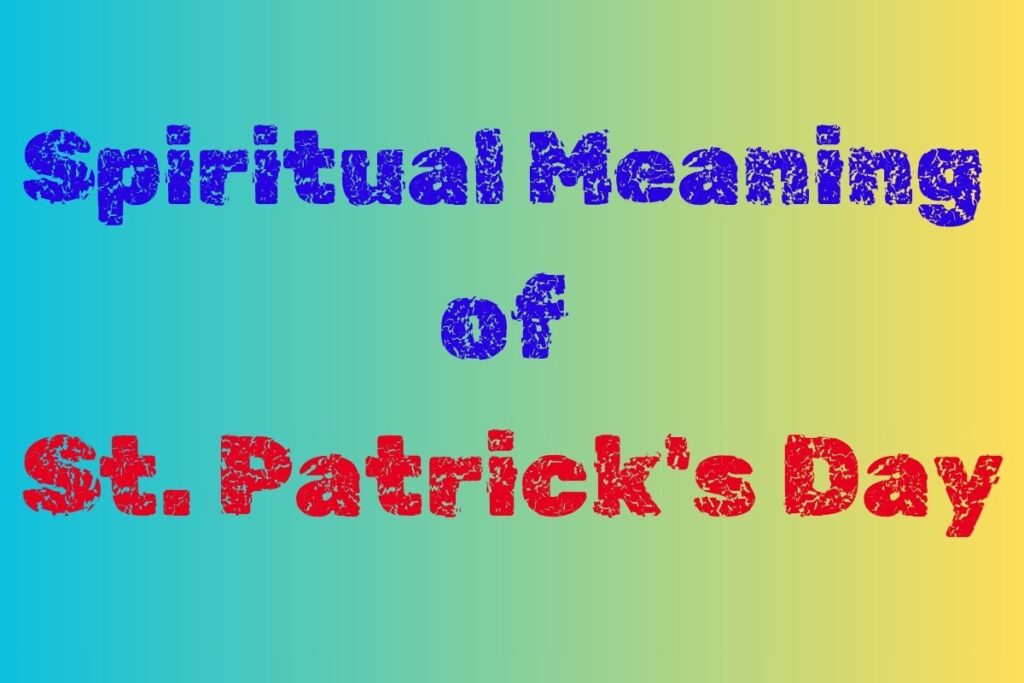Spiritual Meaning of St. Patrick’s Day
Spiritual meaning of St. Patrick’s Day centers around themes of faith, transformation, and divine purpose. It honors St. Patrick’s role in bringing Christianity to Ireland, symbolizing spiritual renewal and personal growth. The holiday also emphasizes forgiveness, resilience, and trusting in divine guidance through life’s challenges.
Spiritual Meaning of St. Patrick’s Day
St. Patrick’s Day celebrated on March 17th, is known for parades, shamrocks, and green attire. However, beyond the festive atmosphere lies a deeper spiritual significance. The holiday is rooted in the story of St. Patrick, the patron saint of Ireland, and holds important lessons about faith, transformation, and divine purpose.
Who Was St. Patrick?
St. Patrick was born in Britain in the late 4th century. As a teenager, he was kidnapped by Irish pirates and sold into slavery in Ireland. During his six years as an enslaved person, Patrick found solace in his Christian faith. After escaping and returning home, he felt a calling to return to Ireland—not as a victim, but as a messenger of Christianity.
Patrick became a priest and, later, a bishop. He spent the rest of his life spreading Christianity throughout Ireland, converting many from paganism to Christianity. His life was one of unwavering faith and service, making him a spiritual leader whose legacy continues to inspire millions today.

Spiritual Themes of St. Patrick’s Day
Though often viewed as a secular celebration, St. Patrick’s Day has a rich spiritual meaning. Understanding the holiday through a spiritual lens brings profound insights into faith, perseverance, and the divine power of transformation.
1. Faith in God’s Guidance
One of St. Patrick’s most influential spiritual lessons is his trust in God’s guidance. When Patrick was enslaved, he prayed constantly for deliverance. His prayers were answered, and he eventually escaped. However, rather than live in comfort, Patrick followed a divine calling and returned to the land where he had been enslaved.
This demonstrates a deep level of trust in God’s plan. Patrick believed God had a higher purpose for him, even when it was difficult to see. This message can resonate with anyone going through struggles. St. Patrick’s story reminds us to believe that there is a reason behind our challenges and that God is always leading us toward a greater purpose.
2. Transformation and Renewal
St. Patrick’s story is one of personal transformation, but it also represents the spiritual transformation of an entire nation. Ireland was largely pagan when Patrick arrived, but many Irish people converted to Christianity through his ministry. This massive spiritual renewal changed the cultural and religious landscape of Ireland forever.
On a personal level, St. Patrick’s Day reminds us that spiritual renewal is always possible. Just as Patrick experienced a shift from slavery to freedom, people can undergo spiritual transformations. The journey may be challenging but can lead to profound change, a deeper connection with the divine, and a renewed sense of purpose.
3. The Power of Forgiveness
Another significant spiritual theme in St. Patrick’s life is forgiveness. After escaping slavery, Patrick could have chosen bitterness or revenge. Instead, he decided to return to the place of his captivity with a message of love and forgiveness. This act of forgiveness wasn’t just personal—it became a powerful tool in spreading the Christian faith.
Forgiveness is often seen as one of the most complex spiritual virtues, but St. Patrick’s story shows how transformative it can be. In forgiving those who wronged him, Patrick found freedom in his heart and fulfilled his mission. His example encourages us to let go of resentment and embrace forgiveness, even when it seems impossible.
4. Embracing Divine Purpose
St. Patrick had a clear sense of divine purpose. He believed God called him to spread Christianity in Ireland. This purpose drove him throughout his life, even in hardship. His commitment to his mission reminds us that every person has a purpose given by God, and living in alignment with that purpose brings fulfillment and spiritual peace.
Discovering one’s divine purpose often requires prayer, reflection, and trust in God’s plan. St. Patrick’s Day is a time to reflect on this. Are we living by our divine purpose? Are we using our gifts and experiences to positively impact the world around us?
Symbols and Their Spiritual Meanings
St. Patrick’s Day is filled with symbols, many of which carry deep spiritual meanings. Understanding these symbols can enrich the holiday.
The Shamrock
One of the most well-known symbols of St. Patrick’s Day is the shamrock. According to legend, St. Patrick used the three-leafed shamrock to explain the concept of the Holy Trinity—the Father, the Son, and the Holy Spirit. The shamrock’s simplicity was an effective teaching tool, and it became associated with Patrick’s mission.
Spiritually, the shamrock symbolizes unity in diversity. Though the three leaves are separate, they are united as one. This can serve as a reminder of God’s presence in all aspects of life and the importance of seeking unity in our spiritual journey.
The Color Green
Green is the color most closely associated with St. Patrick’s Day, symbolizing life, growth, and renewal. Spiritually, green represents the renewal of the soul. Just as nature blossoms in spring, our spirits can also experience growth and new life. The color green serves as a reminder to nurture our spiritual lives and remain open to growth.
The Snake
Another symbol often linked to St. Patrick’s is the snake. Legend has it that St. Patrick drove all the snakes out of Ireland, symbolizing the eradication of evil. While the historical accuracy of this story is debated, its spiritual symbolism remains powerful. Snakes, often seen as symbols of sin or temptation, can represent the inner struggles we must overcome.
St. Patrick’s role in driving out the snakes is a metaphor for overcoming evil and temptation. It’s a call to seek spiritual cleansing and rid ourselves of negative influences that keep us from living a holy and purposeful life.
St. Patrick’s Day Spiritual Meanings in Various Cultures
St. Patrick’s Day is widely recognized as celebrating Irish culture, but its spiritual significance extends beyond its Irish roots. People in different cultures attribute various spiritual meanings to the holiday, often focusing on themes such as faith, transformation, and unity. While the religious roots of the day are connected to Christianity, its spiritual impact is interpreted in diverse ways worldwide.

1. Ireland: The Core of Spirituality and National Identity
St. Patrick’s Day holds profound spiritual meaning in Ireland, deeply connected to the country’s Christian faith and national identity. St. Patrick is credited with bringing Christianity to Ireland, and the day celebrates his role in converting the Irish from paganism to Christianity. The holiday is a time to reflect on Ireland’s spiritual history, honoring the Christian values of faith, forgiveness, and redemption.
Spiritually, St. Patrick’s Day in Ireland emphasizes:
- Faith in Divine Guidance: St. Patrick’s mission to spread Christianity symbolizes trusting in divine purpose.
- Cultural Unity: The day unites the Irish people, not just in celebration but in shared faith and cultural heritage.
2. United States: A Blend of Irish Heritage and Personal Transformation
St. Patrick’s Day has become a major cultural event in the United States, where millions claim Irish descent. While the festivities often focus on parades and parties, many people recognize the deeper spiritual aspects of the holiday.
For Irish Americans and others, the day can symbolize:
- Personal Transformation: St. Patrick’s journey from slavery to sainthood is a powerful symbol of transformation. Many view the day as an opportunity to reflect on their spiritual growth.
- Renewal and Rebirth: The emphasis on green and shamrocks ties in with themes of renewal and nature’s rebirth, linking spiritual rejuvenation with the coming of spring.
- Unity Through Faith: Despite different religious backgrounds, people often use the day to come together in shared cultural and spiritual celebrations, reflecting unity through diversity.
3. Mexico: Embracing Community and Spiritual Brotherhood
St. Patrick’s Day in Mexico is not as widely celebrated as in the U.S. or Ireland. Still, it holds a unique spiritual significance, particularly within the historical context of the Irish soldiers who fought alongside Mexican forces during the Mexican-American War (1846-1848). These soldiers, known as the San Patricios, were Irish immigrants who sympathized with the Mexican cause, primarily due to shared Catholic faith.
For some Mexicans, St. Patrick’s Day is a time to honor:
- Spiritual Brotherhood: The San Patricios symbolizes a deep spiritual connection between the Irish and Mexican people, transcending cultural boundaries through shared faith.
- Solidarity: The day highlights themes of unity and compassion, where faith and mutual respect unite different communities.
4. Japan: Connecting Global Cultures Through Spiritual Reflection
Japan has embraced St. Patrick’s Day as part of its fascination with Western culture, particularly Irish traditions. Although the holiday is more of a cultural event than a religious observance, it carries spiritual undertones in some Japanese communities, where it is seen as a way to celebrate nature, harmony, and global unity.
Spiritual aspects in Japan include:
- Harmony with Nature: The emphasis on green and the coming of spring resonates with Japan’s spiritual appreciation for nature, symbolizing renewal and balance.
- Global Unity: St. Patrick’s Day in Japan is often viewed as celebrating international cultures, fostering a sense of unity and mutual respect between different nations.
5. Nigeria: Faith and Spiritual Resilience
In Nigeria, where Christianity is central in many communities, St. Patrick’s Day is celebrated with a focus on religious significance. Irish missionaries were influential in establishing Catholic education and spreading the Christian faith in Nigeria during the 19th and 20th centuries. As a result, many Nigerian Christians hold St. Patrick in high esteem for his missionary work.
The spiritual meanings in Nigeria include:
- Faith and Evangelism: St. Patrick’s missionary efforts resonate strongly with Nigerian Christians, who view him as a model of faith-driven evangelism.
- Spiritual Resilience: St. Patrick’s perseverance in adversity inspires many Nigerian believers to remain strong in their faith, even during difficult times.
6. Canada: Embracing Cultural and Spiritual Diversity
In Canada, St. Patrick’s Day is celebrated as a cultural and spiritual event reflecting Irish heritage and Canada’s multicultural society. While the religious aspect of the holiday is not always central, many people use the day to explore deeper spiritual themes.
Canadian interpretations often focus on:
- Cultural and Spiritual Diversity: St. Patrick’s Day is seen as an opportunity to celebrate Irish culture and the broader concept of spiritual diversity. It becomes a day to honor different traditions and faiths while acknowledging individuals’ spiritual journeys.
- Renewal and Reflection: As in other cultures, the day is often linked with themes of renewal and personal growth, especially as it falls near the start of spring.
7. Australia: Renewal and Spiritual Growth in Nature
In Australia, St. Patrick’s Day is celebrated with an emphasis on Irish culture. Still, spiritual meanings are also attached to the holiday, particularly about nature and personal growth.
Australians who celebrate the day often reflect on the following:
- Spiritual Growth and Renewal: St. Patrick’s transformation is a metaphor for spiritual growth. Many Australians take this opportunity to reflect on their spiritual journeys.
- Connection with Nature: The emphasis on green and the themes of renewal resonate in Australia, where the natural environment is often seen as a source of spiritual reflection and growth.

Dreaming of St. Patrick’s Day spiritual meaning
Dreaming of St. Patrick’s Day often symbolizes transformation, personal growth, and spiritual renewal. It may reflect a call to trust in divine guidance, embrace forgiveness, or undergo positive life changes. The imagery of green and shamrocks suggests renewal and prosperity, while the presence of St. Patrick could symbolize faith, protection, and overcoming challenges. Such dreams invite reflection on your spiritual journey and potential for inner growth.
Frequently asked questions about Spiritual Meaning of St. Patrick’s Day
What is the True Meaning of St. Patrick’s Day?
The true meaning of St. Patrick’s Day honors St. Patrick’s role in spreading Christianity in Ireland. It reflects themes of faith, transformation, and spiritual renewal. Beyond the celebrations, it serves as a reminder of his missionary work and profound religious impact on Irish culture.
What is the Biblical Meaning of St. Patrick’s Day?
The biblical meaning of St. Patrick’s Day emphasizes evangelism, faith, and spreading the Gospel, as reflected in the Great Commission (Matthew 28:19-20). St. Patrick’s life exemplifies forgiveness, divine guidance, and commitment to Christian teachings, mirroring fundamental biblical values.
What is the Symbolism of Saint Patrick?
Saint Patrick symbolizes faith, transformation, and forgiveness. The shamrock, linked to his teachings, represents the Holy Trinity. His mission to drive out paganism and spread Christianity represents spiritual triumph, and his life is a model of perseverance and devotion to faith.
Conclusion
St. Patrick’s Day is far more than celebrating Irish culture and heritage. At its core, it celebrates faith, transformation, forgiveness, and divine purpose. By reflecting on the spiritual lessons from St. Patrick’s life, we can find inspiration to deepen our faith and commitment to living a life of spiritual meaning.
As we enjoy the festivities of St. Patrick’s Day, let’s also take time to connect with its spiritual roots. In doing so, we can carry the true spirit of the day into our daily lives, seeking transformation, practicing forgiveness, and trusting in God’s guidance every step of the way.







